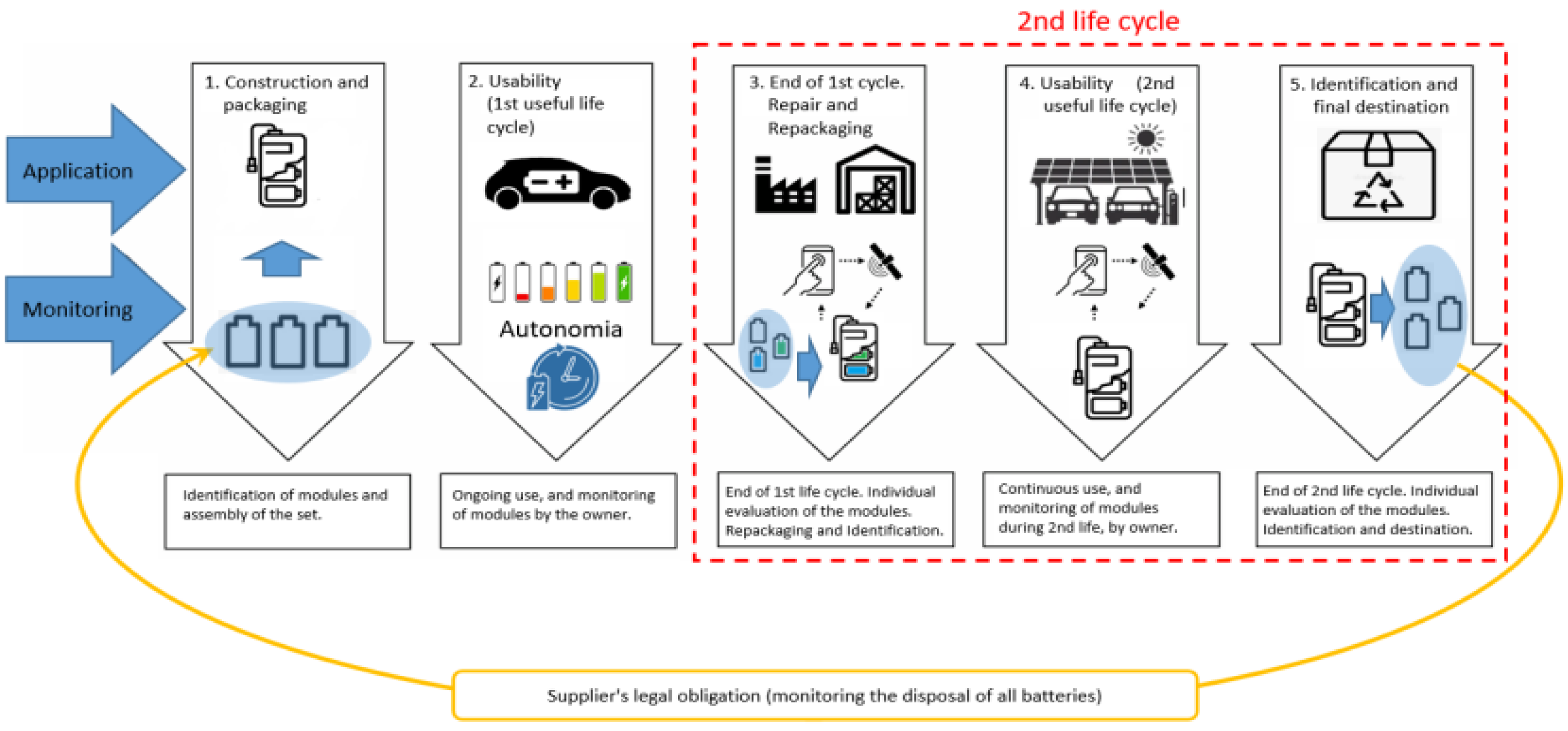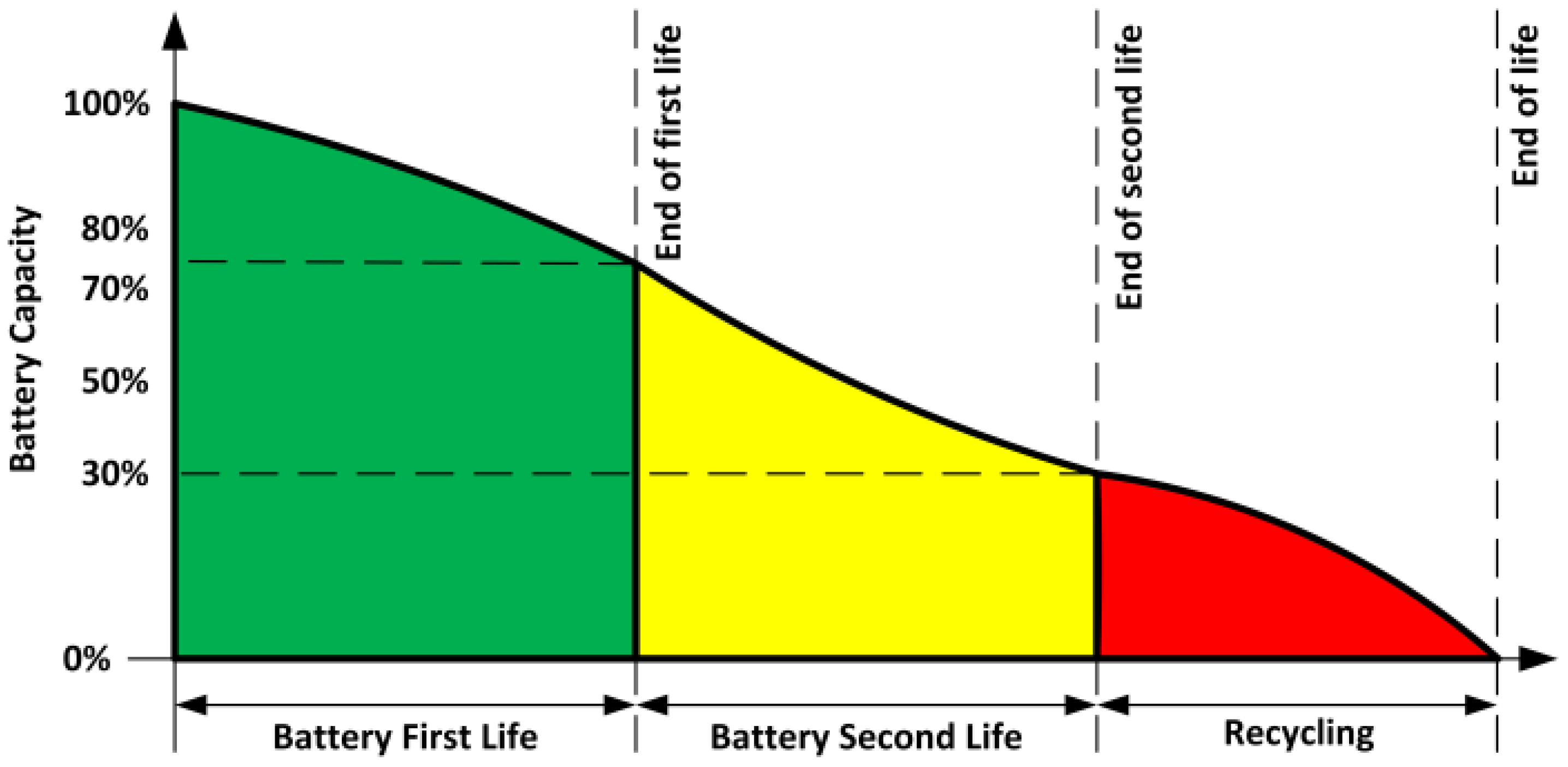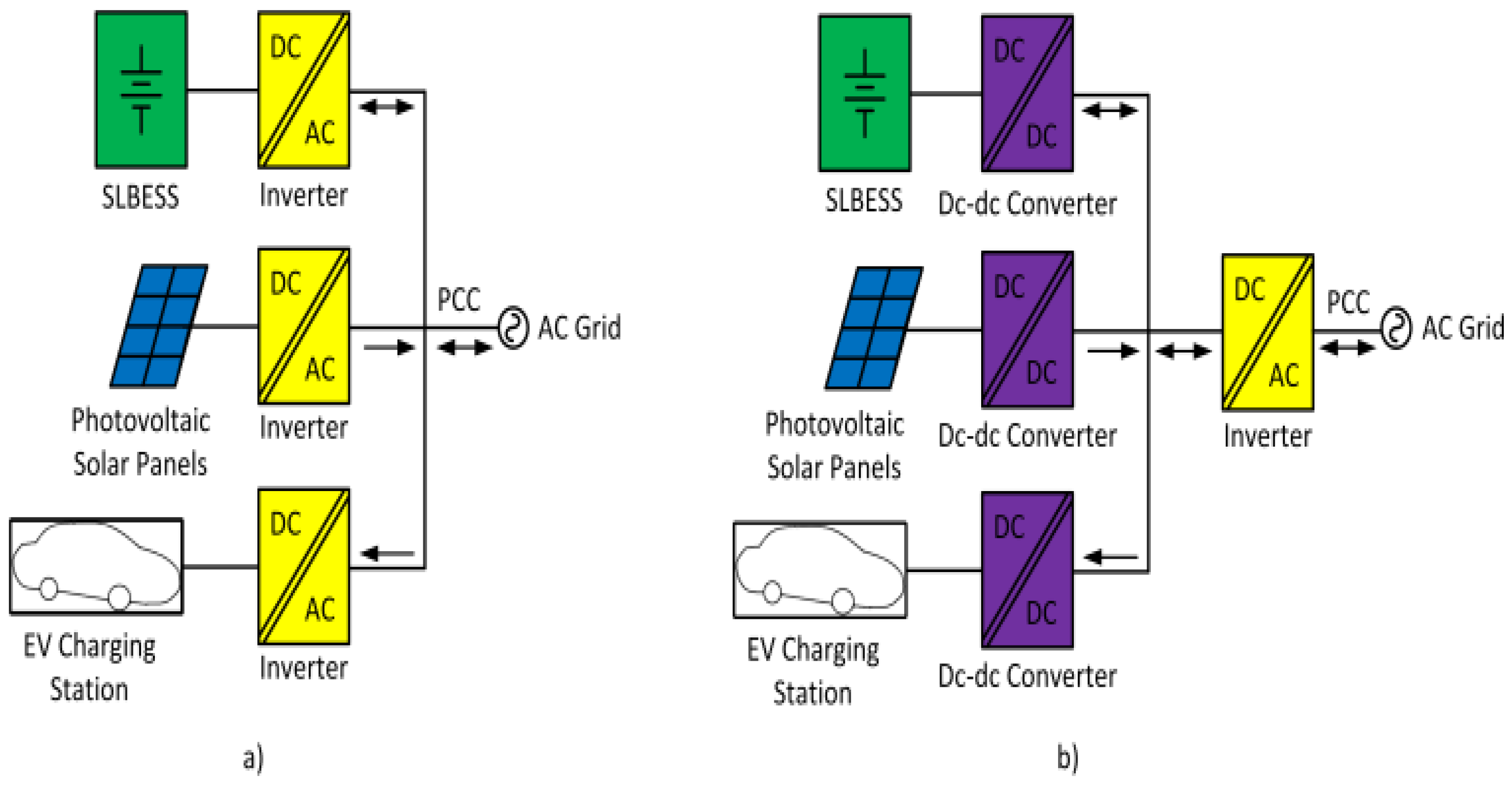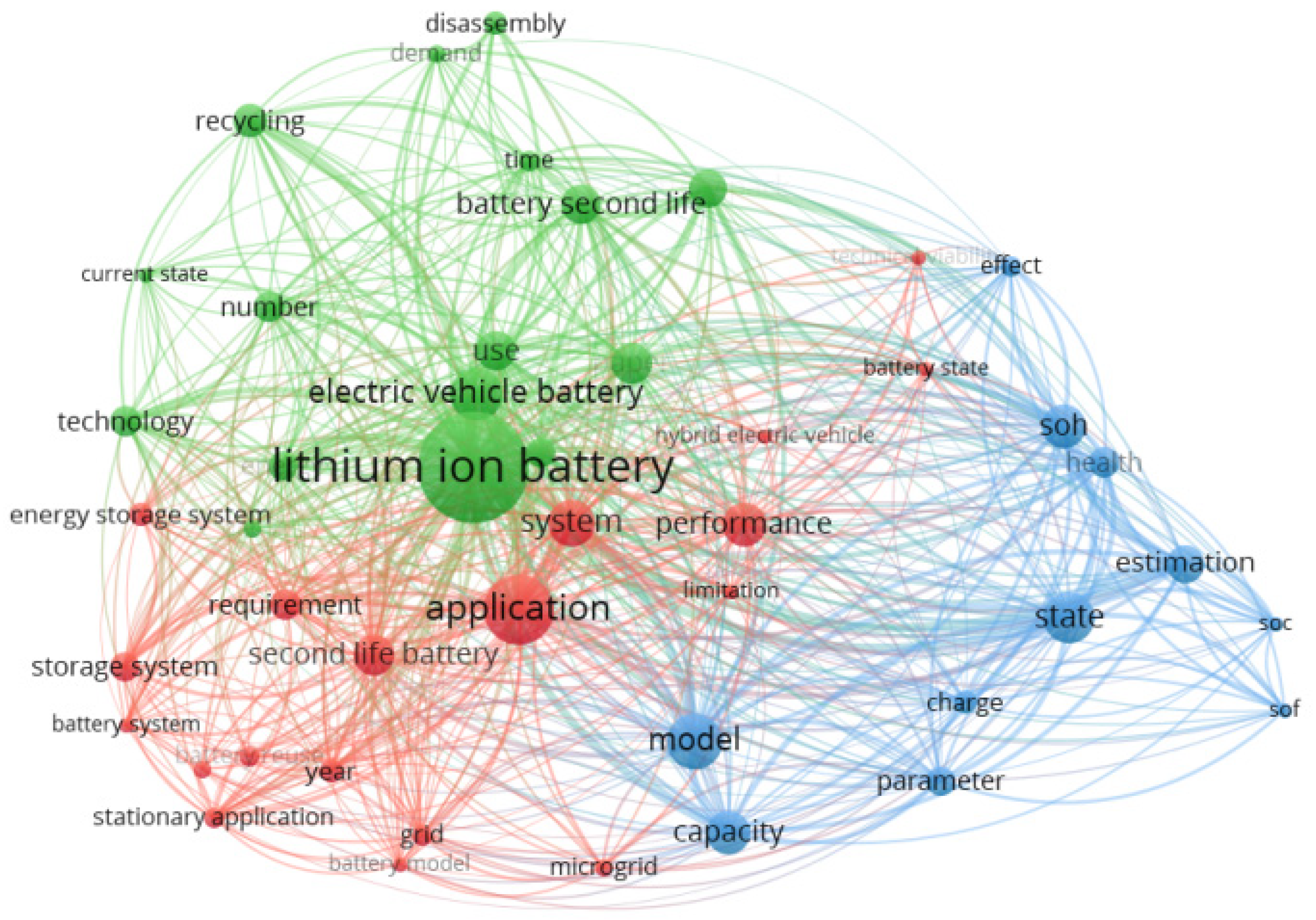Second Life of Lithium-Ion Batteries of Electric Vehicles: A Short Review and Perspectives
Abstract
1. Introduction
2. Second-Life Batteries: Recycling and Reuse Process
- Removal/extraction of covers or opening of the car;
- Removal of protections/covers/insulation covers;
- Disconnection and isolation of low-voltage harnesses;
- Disconnection and isolation of high-voltage harnesses and buses;
- Battery management system (BMS) removal;
- Removal of electrical protection devices;
- Loosening of module fasteners;
- Module removal;
- Cell separation and visual analysis.
- Experimental methods: these are simple and direct methods but are time-consuming and require specific equipment to carry out measurements. This procedure is not recommended for estimation in real time or when the battery is operating. An example is the method of measuring the battery’s internal resistance, which increases with the decreasing of the SOH;
- Model-based methods: this type uses models of battery behavior, such as the dual polarization electrical model. They are based on algorithms and require computational effort. They can be used during battery operation. An example is the Kalman filter estimation [24];
- Methods based on machine learning: these methods combine both experimental techniques and model-based approaches. Allowing to work with non-parametric data, they are robust and accurate. In addition, they request the processing capacity to implement the algorithms and an adequate database for better performance. The estimation of SOH using fuzzy logic or neural networks are examples of this class.
3. Second-Life Battery Approaches
3.1. Battery Performance Estimation
3.2. Battery Disassembly
3.3. Battery Application
4. Discussion and Perspectives
- The methodology for the battery classification process: to classify batteries according to their SOH algorithms based on artificial intelligence, neural networks and machine learning can be used. The development of these algorithms and their application is a topic at the forefront of knowledge both from a theoretical and technological point of view;
- Development of dedicated BMSs: the BMS plays a vital role in the correct and safe operation of each battery and the entire energy storage system. BMSs removed from vehicles’ battery packs cannot be reused, as they are designed to operate with the number of batteries in the vehicle and with the specifications demanded by the automotive application. Therefore, new dedicated BMSs must be designed and developed for the application of second-life batteries;
- Development of the connectivity system: this system will allow real-time monitoring of the individual parameters of each battery. The project has the potential for innovation in terms of sensors, communication, and the processing of collected data. The question of controlling the useful life of the individual parts of a battery pack is necessary for the manufacturer, who has the obligation to continuously track the rearrangements of subsets for use in second life, identifying the entire set so that, in a short future, they can monitor their replacement and/or disposal in a controlled manner and thus be able to properly dispose of them, in accordance with legal and environmental premises. In this way, in addition to electrical parameters, identification parameters can also be the focus of information on connectivity devices;
- Development of the SLBESS: the design must take into account mechanical, electrical, thermal, and safety constraints. As it is a multidisciplinary project, computational tools that provide numerical simulations in multiple physics domains must be used, particularly those that employ finite element methods and/or computational fluid dynamics. Additionally, computer-aided design (CAD) tools must be used to design the cabinet focusing on the constructive characteristics of the cabinet, the fixing of the batteries inside the rack, the positioning of the electrical and thermal sensors, and the positioning of the harnesses and cabling, control, protection, and cooling devices, among others.
5. Conclusions
- The battery pack disassembly process is complex because each manufacturer performs the assembly process differently. In addition, the disassembly process requires qualified people with personal protection to avoid the risk of accidents;
- Continuous monitoring of the internal parameters of the battery so that the right moment to replace the battery application can be estimated;
- To assemble the pack with the second-life cells, it is necessary to ensure that the cells are in excellent condition by checking the SoH and joining cells with similar use characteristics, with the classification process becoming essential;
- Several techniques, including machine learning, have been used for the classification process for knowing the internal parameters of the cells, their SoC, and their remaining energy, and so it is possible to assemble second-life packs with cells whose parameters are similar;
- All of the steps involved in using second-life batteries must follow a methodology capable of making the whole process reliable, safe, and cost-effective in systems and equipment to reach a higher technology readiness level.
- Together with generating energy through renewable sources to recharge electric ve- hicles, the second life of lithium-ion batteries is fundamental for sustainable electric mobility, promoting a new business model and the circular economy.
Author Contributions
Funding
Data Availability Statement
Conflicts of Interest
Abbreviations
| BESS | Battery energy storage system |
| BMS | Battery management system |
| CAD | Computer-aided design |
| DE | Differential evolution |
| DOD | Depth of discharge |
| ESG | Environmental social governance |
| EV | Electric vehicle |
| GLM | Generalized linear model |
| GM | General Motors |
| HI | Health indicators |
| IEEE | Institute of Electrical and Electronics Engineers |
| LCC | Life cycle cost |
| LFP | Lithium iron phosphate |
| LIB | Lithium-ion battery |
| MDPI | Multidisciplinary Digital Publishing Institute |
| MLP | Multilayer perceptron |
| MLR | Multiple linear regression |
| MRE | Mean relative error |
| NFC | Near-field communication |
| PPE | Personal protective equipment |
| PRISMA | Preferred reporting items of systematic reviews and meta-analyses |
| PSO | Particle swarm optimization |
| R&D | Research and development |
| RFIDs | Radio frequency identification devices |
| RIM | Robert Mondavi Institute |
| RMSE | Roots mean square error |
| RUL | Remaining useful life |
| SDGs | Sustainable development goals |
| SLB | Second-life battery |
| SLBESS | Second-life battery energy storage system |
| SoC | State-of-charge |
| SoH | State-of-health |
| TCN | Temporal convolutional neural network |
References
- Mora Rollo, A.; Rollo, A.; Mora, C. The tree-lined path to carbon neutrality. Nat. Rev. Earth Environ. 2020, 1, 332. [Google Scholar] [CrossRef]
- Chen, J.; Cui, H.; Xu, Y.; Ge, Q. Long-term temperature and sea-level rise stabilization before and beyond 2100: Estimating the additional climate mitigation contribution from China’s recent 2060 carbon neutrality pledge. Environ. Res. Lett. 2021, 16, 074032. [Google Scholar] [CrossRef]
- Findlay, A. Climate mitigation through Indigenous forest management. Nat. Clim. Change 2021, 11, 371–373. [Google Scholar] [CrossRef]
- Lander, L.; Cleaver, T.; Rajaeifar, M.A.; Nguyen-Tien, V.; Elliott, R.J.; Heidrich, O.; Kendrick, E.; Edge, J.S.; Offer, G. Financial viability of electric vehicle lithium-ion battery recycling. Iscience 2021, 24, 102787. [Google Scholar] [CrossRef]
- Noura, N.; Boulon, L.; Jemeï, S. A review of battery state of health estimation methods: Hybrid electric vehicle challenges. WorldElectric Veh. J. 2020, 11, 66. [Google Scholar] [CrossRef]
- Lv, F.; Wang, Z.; Shi, L.; Zhu, J.; Edström, K.; Mindemark, J.; Yuan, S. Challenges and development of composite solid-state electrolytes for high-performance lithium ion batteries. J. Power Sources 2019, 441, 227175. [Google Scholar] [CrossRef]
- Li, J.; Xiong, R.; Mu, H.; Cornélusse, B.; Vanderbemden, P.; Ernst, D.; Yuan, W. Design and real-time test of a hybrid energy storage system in the microgrid with the benefit of improving the battery lifetime. Appl. Energy 2018, 218, 470–478. [Google Scholar] [CrossRef]
- Haram, M.H.S.M.; Lee, J.W.; Ramasamy, G.; Ngu, E.E.; Thiagarajah, S.P.; Lee, Y.H. Feasibility of utilising second life EV batteries: Applications, lifespan, economics, environmental impact, assessment, and challenges. Alex. Eng. J. 2021, 60, 4517–4536. [Google Scholar] [CrossRef]
- Graber, G.; Calderaro, V.; Galdi, V.; Piccolo, A. Battery second-life for dedicated and shared energy storage systems supporting EV charging stations. Electronics 2020, 9, 939. [Google Scholar] [CrossRef]
- Casals, L.C.; Amante García, B.; Canal, C. Second life batteries lifespan: Rest of useful life and environmental analysis. J. Environ. Manag. 2019, 232, 354–363. [Google Scholar] [CrossRef]
- Tricco, A.C.; Lillie, E.; Zarin, W.; O'Brien, K.K.; Colquhoun, H.; Levac, D.; Moher, D.; Peters, M.D.J.; Horsley, T.; Weeks, L.; et al. PRISMA Extension for Scoping Reviews (PRISMA-ScR): Checklist and Explanation. Ann. Intern. Med. 2018, 169, 467–473. [Google Scholar] [CrossRef] [PubMed]
- Hossain, E.; Murtaugh, D.; Mody, J.; Faruque, H.M.R.; Sunny, M.S.H.; Mohammad, N. A comprehensive review on second-life batteries: Current state, manufacturing considerations, applications, impacts, barriers & potential solutions, business strategies, and policies. IEEE Access 2019, 7, 73215–73252. [Google Scholar] [CrossRef]
- Cheng, X.B.; Liu, H.; Yuan, H.; Peng, H.J.; Tang, C.; Huang, J.Q.; Zhang, Q. A perspective on sustainable energy materials for lithium batteries. SusMat 2021, 1, 38–50. [Google Scholar] [CrossRef]
- Aishova, A.; Park, G.T.; Yoon, C.S.; Sun, Y.K. Cobalt-free high-capacity Ni-rich layered Li [Ni0. 9Mn0. 1] O2 cathode. Adv. Energy Mater. 2020, 10, 1903179. [Google Scholar] [CrossRef]
- Slattery, M.; Dunn, J.; Kendall, A. Transportation of electric vehicle lithium-ion batteries at end-of-life: A literature review. Resour. Conserv. Recycl. 2021, 174, 105755. [Google Scholar] [CrossRef]
- Kautz, E.; Bozkurt, Ö.F.; Emmerich, P.; Baumann, M.; Weil, M. Potentials and challenges of a circular economy. A systematic review for the use case of lithium-ion batteries. Matériaux Tech. 2021, 109, 503. [Google Scholar] [CrossRef]
- Melin, H.E. State-of-the-art in reuse and recycling of lithium-ion batteries–A research review. Circ. Energy Storage 2019, 1, 1–57. [Google Scholar]
- Margoni, L. UC San Diego Selected as Energy Storage North America 2016 Innovation Award Winner; University of California San Diego: La Jolla, CA, USA, 2018. [Google Scholar]
- Mahmud, S.; Rahman, M.; Kamruzzaman, M.; Ali, M.O.; Emon, M.S.A.; Khatun, H.; Ali, M.R. Recent advances in lithium-ion battery materials for improved electrochemical performance: A review. Results Eng. 2022, 15, 100472. [Google Scholar] [CrossRef]
- Dalala, Z.M.; Saadeh, O.S.; Zahid, Z.U. Second Life Battery Energy Storage System: Modular Interface and Control. In Proceedings of the 2022 IEEE 13th International Symposium on Power Electronics for Distributed Generation Systems (PEDG), Kiel, Germany, 26–29 June 2022; IEEE: Piscataway, NJ, USA, 2022; pp. 1–6. [Google Scholar]
- Montes, T.; Etxandi-Santolaya, M.; Eichman, J.; Ferreira, V.J.; Trilla, L.; Corchero, C. Procedure for Assessing the Suitability of Battery Second Life Applications after EV First Life. Batteries 2022, 8, 122. [Google Scholar] [CrossRef]
- Castillo-Martínez, D.H.; Rodríguez-Rodríguez, A.J.; Soto, A.; Berrueta, A.; Vargas-Requena, D.T.; Matias, I.R.; Sanchis, P.; Ursúa, A.; Rodríguez-Rodríguez, W.E. Design and on-field validation of an embedded system for monitoring second-life electric vehicle 462 lithium-ion batteries. Sensors 2022, 22, 6376. [Google Scholar] [CrossRef]
- Surya, S.; Rao, V.; Williamson, S.S. Comprehensive review on smart techniques for estimation of state of health for battery management system application. Energies 2021, 14, 4617. [Google Scholar] [CrossRef]
- Bandini, G.; Caposciutti, G.; Marracci, M.; Buffi, A.; Tellini, B. Characterization of lithium-batteries for high power applications. J. Energy Storage 2022, 50, 104607. [Google Scholar] [CrossRef]
- Li, W.; Rentemeister, M.; Badeda, J.; Jöst, D.; Schulte, D.; Sauer, D.U. Digital twin for battery systems: Cloud battery management system with online state-of-charge and state-of-health estimation. J. Energy Storage 2020, 30, 101557. [Google Scholar] [CrossRef]
- Selvabharathi, D.; Muruganantham, N. Experimental analysis on battery based health monitoring system for electric vehicle; International Conference on Advances in Materials Research-2019. Mater. Today Proc. 2021, 45, 1552–1558. [Google Scholar] [CrossRef]
- Gowda, S.N.; Eraqi, B.A.; Nazaripouya, H.; Gadh, R. Assessment and tracking electric vehicle battery degradation cost using blockchain. In Proceedings of the 2021 IEEE Power & Energy Society Innovative Smart Grid Technologies Conference (ISGT), Washington, DC, USA, 16–18 February 2021; IEEE: Piscataway, NJ, USA, 2021; pp. 1–5. [Google Scholar]
- Hristova, T. Tracking of the battery materials of electric vehicles in the mining industry via a blockchain. Proc. IOP Conf. Ser. Earth Environ. Science. 2022, 970, 012012. [Google Scholar] [CrossRef]
- Birou, C.; Roboam, X.; Radet, H.; Lacressonnière, F. Techno-economic analysis of second-life lithium-ion batteries integration in microgrids. In Proceedings of the 2020 22nd European Conference on Power Electronics and Applications (EPE’20 ECCE Europe), Lyon, France, 7–11 September 2020; IEEE: Piscataway, NJ, USA, 2020; pp. 1–10. [Google Scholar]
- Wang, S.; Jin, S.; Bai, D.; Fan, Y.; Shi, H.; Fernandez, C. A critical review of improved deep learning methods for the remaining useful life prediction of lithium-ion batteries. Energy Rep. 2021, 7, 5562–5574. [Google Scholar] [CrossRef]
- Bhatt, A.; Ongsakul, W.; Madhu, N.; Singh, J.G. Machine learning-based approach for useful capacity prediction of second-life batteries employing appropriate input selection. Int. J. Energy Res. 2021, 45, 21023–21049. [Google Scholar] [CrossRef]
- Braco, E.; San Martín, I.; Sanchis, P.; Ursúa, A. Fast capacity and internal resistance estimation method for second-life batteries from electric vehicles. Appl. Energy 2023, 329, 120235. [Google Scholar] [CrossRef]
- Sanz-Gorrachategui, I.; Pastor-Flores, P.; Pajovic, M.; Wang, Y.; Orlik, P.V.; Bernal-Ruiz, C.; Bono-Nuez, A.; Artal-Sevil, J.S. Remaining Useful Life Estimation for LFP Cells in Second-Life Applications. IEEE Trans. Instrum. Meas. 2021, 70, 2505810. [Google Scholar] [CrossRef]
- Bockrath, S.; Waldhör, S.; Ludwig, H.; Lorentz, V. State of Health Estimation using a Temporal Convolutional Network for an Efficient Use of Retired Electric Vehicle Batteries within Second-Life Applications. In Artificial Intelligence for Digitising Industry–Applications; River Publishers: Aalborg, Denmark, 2022; pp. 21–34. [Google Scholar]
- Castanho, D.; Guerreiro, M.; Silva, L.; Eckert, J.; Antonini Alves, T.; Tadano, Y.d.S.; Stevan, S.L., Jr.; Siqueira, H.V.; Corrêa, F.C. Method for SoC Estimation in Lithium-Ion Batteries Based on Multiple Linear Regression and Particle Swarm Optimization. Energies 2022, 15, 6881. [Google Scholar] [CrossRef]
- Mannuß, O.; Borchardt, I.; Mandel, J.; Sauer, A. Approach for a Systematic Derivation of Risks During Disassembly of Traction Batteries. In Proceedings of the 9th Annual World Conference of the Society for Industrial and Systems Engineering, 2020 SISE Virtual Conference, Online, 17–18 September 2020; Volume 6. [Google Scholar]
- Tao, Y.; Rahn, C.D.; Archer, L.A.; You, F. Second life and recycling: Energy and environmental sustainability perspectives for high-performance lithium-ion batteries. Sci. Adv. 2021, 7, eabi7633. [Google Scholar] [CrossRef]
- Or, T.; Gourley, S.W.; Kaliyappan, K.; Yu, A.; Chen, Z. Recycling of mixed cathode lithium-ion batteries for electric vehicles: Current status and future outlook. Carbon Energy 2020, 2, 6–43. [Google Scholar] [CrossRef]
- Gumanová, V.; Sobotová, L. Proposal for Disassembly of Electric Vehicle Batteries used in the Volkswagen Jetta Hybrid System. In Proceedings of the 2019 International Council on Technologies of Environmental Protection (ICTEP), Starý Smokovec, Slovakia, 23–25 October 2019; IEEE: Piscataway, NJ, USA, 2019; pp. 100–106. [Google Scholar]
- Hellmuth, J.F.; DiFilippo, N.M.; Jouaneh, M.K. Assessment of the automation potential of electric vehicle battery disassembly. J. Manuf. Syst. 2021, 59, 398–412. [Google Scholar] [CrossRef]
- Kay, I.; Farhad, S.; Mahajan, A.; Esmaeeli, R.; Hashemi, S.R. Robotic Disassembly of Electric Vehiclesrsquo; Battery Modules for Recycling. Energies 2022, 15, 4856. [Google Scholar] [CrossRef]
- Chai, S.; Xu, N.Z.; Niu, M.; Chan, K.W.; Chung, C.Y.; Jiang, H.; Sun, Y. An Evaluation Framework for Second-Life EV/PHEV Battery Application in Power Systems. IEEE Access 2021, 9, 152430–152441. [Google Scholar] [CrossRef]
- Jung, W.; Jeong, J.; Kim, J.; Chang, D. Optimization of hybrid off-grid system consisting of renewables and Li-ion batteries. J. Power Sources 2020, 451, 227754. [Google Scholar] [CrossRef]
- Martinez-Laserna, E.; Sarasketa-Zabala, E.; Sarria, I.V.; Stroe, D.I.; Swierczynski, M.; Warnecke, A.; Timmermans, J.M.; Goutam, S.; Omar, N.; Rodriguez, P. Technical viability of battery second life: A study from the ageing perspective. IEEE Trans. Ind. Appl. 2018, 54, 2703–2713. [Google Scholar] [CrossRef]




Disclaimer/Publisher’s Note: The statements, opinions and data contained in all publications are solely those of the individual author(s) and contributor(s) and not of MDPI and/or the editor(s). MDPI and/or the editor(s) disclaim responsibility for any injury to people or property resulting from any ideas, methods, instructions or products referred to in the content. |
© 2023 by the authors. Licensee MDPI, Basel, Switzerland. This article is an open access article distributed under the terms and conditions of the Creative Commons Attribution (CC BY) license (https://creativecommons.org/licenses/by/4.0/).
Share and Cite
Illa Font, C.H.; Siqueira, H.V.; Machado Neto, J.E.; Santos, J.L.F.d.; Stevan, S.L., Jr.; Converti, A.; Corrêa, F.C. Second Life of Lithium-Ion Batteries of Electric Vehicles: A Short Review and Perspectives. Energies 2023, 16, 953. https://doi.org/10.3390/en16020953
Illa Font CH, Siqueira HV, Machado Neto JE, Santos JLFd, Stevan SL Jr., Converti A, Corrêa FC. Second Life of Lithium-Ion Batteries of Electric Vehicles: A Short Review and Perspectives. Energies. 2023; 16(2):953. https://doi.org/10.3390/en16020953
Chicago/Turabian StyleIlla Font, Carlos Henrique, Hugo Valadares Siqueira, João Eustáquio Machado Neto, João Lucas Ferreira dos Santos, Sergio Luiz Stevan, Jr., Attilio Converti, and Fernanda Cristina Corrêa. 2023. "Second Life of Lithium-Ion Batteries of Electric Vehicles: A Short Review and Perspectives" Energies 16, no. 2: 953. https://doi.org/10.3390/en16020953
APA StyleIlla Font, C. H., Siqueira, H. V., Machado Neto, J. E., Santos, J. L. F. d., Stevan, S. L., Jr., Converti, A., & Corrêa, F. C. (2023). Second Life of Lithium-Ion Batteries of Electric Vehicles: A Short Review and Perspectives. Energies, 16(2), 953. https://doi.org/10.3390/en16020953








